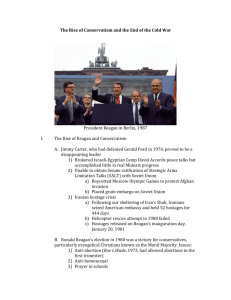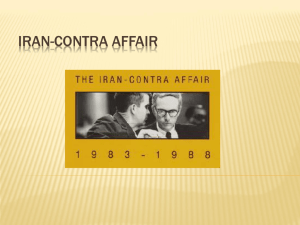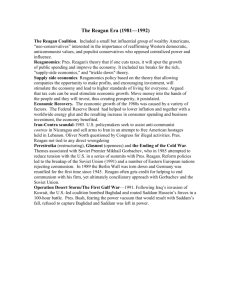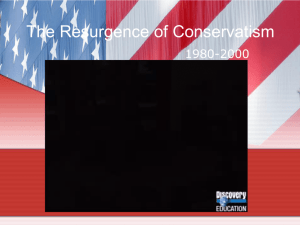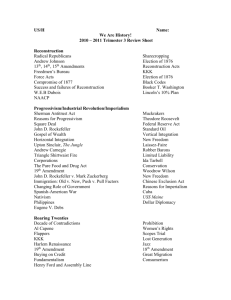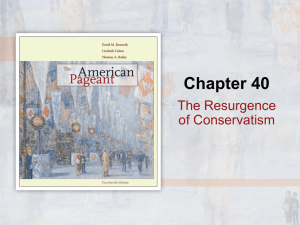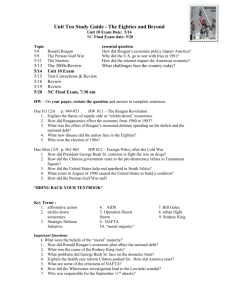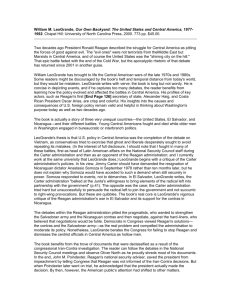The Reagan Years - Campbell County Schools
advertisement
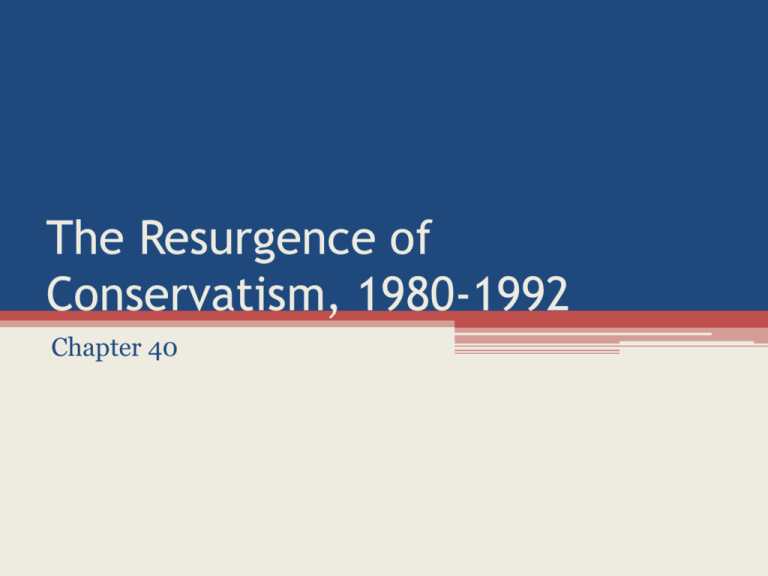
The Resurgence of Conservatism, 1980-1992 Chapter 40 Liberalism • In general: • Believe government should regulate economy to protect people from the power of large corporations and wealthy elites • Government should play active role in helping disadvantaged Americans through social programs and putting tax burden on wealthier people • Suspicious of attempts by government to regulate social behavior • Believe most social problems have their roots in economic inequality Conservatism • In general: • Distrust government and support original intent of Constitution • Believe governmental power should be divided to limit ability to intrude into peoples lives • If government regulates the economy it makes the economy less efficient, leading to more poverty • Free enterprise system • Oppose high taxes and government programs that reduce the amount of freedom in society • Usually believe that religious faith is vitally important to sustaining society The Rise of the Sunbelt • 1950s and early 1960s conservatives generally split their votes between Republicans and Democrats • Southern conservatives usually voted for the Democrats, Western conservatives usually voted for the Republicans ▫ Essentially cancelled each other out • Party that won the heavily populated Northeast (usually Democrats) would win the election Suburban Conservatism • Many people flocked to the suburbs during the 1960s and 1970s to escape the chaos of the cities • Became resentful that their money was going to pay high taxes • Some groups formed in California and then other states that proposed lower taxes and many middle-class Americans got on board The Religious Right • Many people were drawn to conservatism because they believed that society was breaking down with a loss of values and morals • The largest group within the social conservative movement was evangelical Protestant Christians • They believe they are saved from their sins through being “born again” and a personal commitment to follow Jesus Christ Televangelism • After WWII a religious revival began and Protestant ministers like Billy Graham and Oral Roberts built national followings • By the 1970s, about 70 million Americans described themselves as “born again” and groups owned their own newspapers, magazines, radio stations, and television networks • They used their influence to register new voters who backed conservative candidates and issues Conservatism and the Cold War • Support for conservative ideas began to revive because of the Cold War • Struggle against communism got people talking about the role of the government in the economy • Communism rejected religion and emphasized materialism • Democracy vs. Communism became the battle of good vs. evil and many religious Americans turned to conservatism Changing the Economy • Reagan wanted more money in people’s wallets by reducing taxes • “Reaganomics” was based on supply-side economics ▫ Cutting taxes gives more money to businesses and investors who supplied goods for consumers to buy ▫ In theory, they would hire more people and produce more goods and services Foreign Policy • Reagan believed in a tough approach to the USSR • Favored large defense budgets and spent $1.1 trillion over 5 years on new weapons and technology ▫ SDI (Strategic Defense Initiative), aka “Star Wars” proposed the creation of a massive satellite shield in space to intercept and destroy incoming Soviet missiles • USSR was upset at the buildup • He wanted to continue to actively fight communism abroad Recession and Recovery • The Federal Reserve Bank raised interest rates to reduce inflation when the economy took a downturn and this hurt businesses and consumers • Unemployment reached 10.8% and several hundred businesses were going bankrupt each week • Reaganomics helped the country to recover from the recession • Despite tough economic times and a growing deficit, Americans stood behind Reagan Patriotic Renewal • The 1984 Olympic Games were held in Los Angeles and some Communist countries (like the USSR and East Germany) boycotted the games because the US had boycotted the 1980 Moscow games • Because of this we won an unusually high number of medals • We celebrated the centennial of the Statue of Liberty in NY harbor in 1986 and she had been refurbished • 1987 we celebrated the 200th anniversary of the Constitution • African Americans were being elected to office in record numbers • Reagan signed the bill that made Martin Luther King, Jr.’s birthday a national holiday The S&L Scandal • Savings and loan banks (called S&L) were deregulated under Reagan and allowed to make riskier but more profitable investments • Officials took advantage of this and made risky investments in an overheated real estate market, but when the market cooled down many S&Ls collapsed taking $2.6 billion in depositors’ savings with them • Because the banks were FDIC insured, taxpayers had to make up the billions of dollars lost and a number of banking officials were prosecuted for their role in the scandal The Iran-Contra Affair • The Reagan administration sought to undermine the Marxist government in Nicaragua and the CIA trained and armed Nicaraguan “Contras”, violating laws on US intervention in affairs of foreign countries • Congress banned military aid to the Contras, but some members of the Reagan administration still believed the aid was justified • These officials took the profits from secret arms sales, meant to encourage the release of American hostages held in Lebanon by pro-Iranian terrorists, to Iran and sent the profits to the Contras • The scandal became public in the fall of 1986 and Oliver North took the blame • It was the most serious criticism the Reagan administration ever faced, but Reagan claimed no involvement The Space Shuttle • The shuttle program became the new focus for NASA, as it was a reusable way to go to space • The shuttle Columbia became the first shuttle flight in April 1981 • In 1983, Sally Ride became the first American woman in space • NASA recruited a teacher to travel into space to promote the civilian side of the program • In January 1986 Christa McAuliffe, a teacher from NH, joined 6 others on the Challenger • The shuttle lifted off and all on board were killed when it exploded A Decade of Indulgence • Status symbols like expensive watches and luxury cars became important • Popular television shows like Dallas and Dynasty glamorized wealth • Baby boomers shaped the culture and since they wanted wealth, the rest of society did too • By the mid 1990s the top 5% of Americans made 21% of the nation’s income Technology and the Media • Cable and satellite television became popular with dozens of channels • CNN became the first all-news television network • In 1987 the new Fox network added programming for a younger audience • Talk shows offered people new program formats • MTV went on the air in 1981 and was an instant success, launching artists like Michael Jackson and Madonna • Rap music and break dancing caught on • Video arcades were popular meeting places for young people and home gaming systems grew in popularity by the mid 80s Crime, Drugs, and Alcohol • Drug use in cities, backed by a network of gangs that fought to protect territory, became a major problem • First lady Nancy Reagan started a “Just Say No” campaign, but drug use continued to worsen • Teen drinking was also a concern • When MADD encouraged Congress to act they cut highway funds to any state that did not raise the legal drinking age to 21 and all states quickly complied A Deadly Epidemic • • • • • In 1981 researchers identified a disease that caused seemingly healthy young men to become sick and die and identified it as AIDS AIDS weakens the immune system and lowers resistance to illnesses like pneumonia and several types of cancer A few people got the disease from blood transfusions, others got it from sharing drug needles and from sexual partners In 1987 alone more than 28,000 cases of AIDS were diagnosed in the US and more than 100,000 cases between 1981 and 1988 The epidemic brought visibility to the gay and lesbian community and many organizations were formed to increase tolerance of homosexuality Activism • Environmental activism of the 1970s continued into the 1980s • Rock musicians, often criticized for promoting drug use and loose sexual behavior, focused on making a positive difference by putting on benefit concerts to aid everyone from farmers to starving people in Ethiopia • Older Americans became very political, opposing cuts in Social Security or Medicare • Author Squelle http://en.wikipedia.org/wiki/ File:Live_Aid_at_JFK_Stadiu m,_Philadelphia,_PA.jpg A Home in Space • Between September 1988 and December 2002 the shuttle completed 87 missions and placed many satellites into orbit • The space station, built by 16 nations as a base for space exploration, was one reason that NASA built the shuttle • The shuttle began assembling the ISS in 1998 and the first crew arrived in 2000 • On February 1, 2003 the shuttle Columbia came apart while reentering the earth’s atmosphere and all seven crew members were killed • Now, the future of the space program in America is in jeopardy Computers for Everyone • The world’s first electronic digital computer, called ENIAC (Electronic Numerical Integrator and Computer) was created in 1946, weighing over 30 tons and the size of a small house • Ed Uthman • The size of processors gradually became http://en.wikipedia.org/wiki/ smaller File:Apple_I_Computer.jpg • This allowed Steve Wozniak and Steve Jobs to build a small computer for themselves • In 1976 they created Apple I, and the following year they introduced the Apple II, the first practical and affordable home computer • Apple’s success sparked extreme competition and IBM introduced its own home computer (the “PC”) in 1981 • Apple responded in 1984 with the Macintosh, an even more user-friendly machine Bill Gates and Microsoft • 19 year-old Harvard dropout Bill Gates co-founded Microsoft to design PC software • In 1980, IBM hired Microsoft to • World Economic Forum develop an operating system for its http://en.wikipedia.org/wiki/ new PC and Gates paid a Seattle File:Bill_Gates_in_WEF_,200 programmer $50,000 for the rights 7.jpg to his software and made some changes to create the MS-DOS (Microsoft Disk Operating System) • In 1985 Microsoft introduced “Windows” which used mouseactivated on-screen icons • By the late 1990s many workers used home computers and e-mail to “telecommute”, or work from home The Telecommunications Revolution • In the 1970s, 80s, and 90s the government loosened telecommunications regulations allowing more companies to compete in the telephone and television industries • In 1996 Congress passed the Telecommunications Act which allowed phone companies to compete with each other and to send television signals, but also allowed cable companies to offer telephone service • This paved the way for webenabled cell phones The Rise of the Internet • The internet let computer users post and receive information and communicate with each other • It had roots in a U.S. Defense Department project that linked government agencies, contractors, and scientists to communicate through electronic mail • The internet became accessible to civilians because of efforts by the National Science Foundation in 1985 • It expanded almost 300% between 1997 and 2000 • The internet spawned a “dot-com” economy • Online companies were created and invested in without ever earning any actual money, which caused problems in the future Unraveling the Secrets of Life • James Watson and his colleague Francis Crick deciphered the structure of DNA in 1953 • Once scientists learned how to read the message of DNA their new knowledge improved medical research and provided law enforcement with new methods of identification • Artificial genes and genetic engineering for plants, animals, and humans was made easier The Human Genome Project • Scientists wanted to map out the human genome by recording the DNA sequence of the human species • The Human Genome Project began in 1990 when the National Institutes of Health decided to place all of the HGP’s data on the Internet to make it available to scientists everywhere • In 2001 the project completed its first map of the human genome • Medical researchers expected that this info would help them determine which genes make people more likely to get diseases and improve medical diagnoses, preventive medication, and find cures
